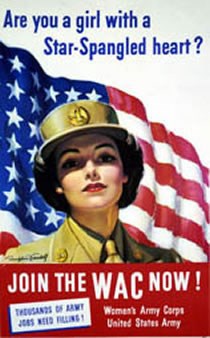
Women have a long tradition of service in the United States armed forces. The names Margaret Corbin and Molly Pitcher of the Revolution are well known. Lucy Brewer served as a Marine on the USS Constitution, and Doctor Mary Walker was an Army surgeon during the Civil War. The accomplishments of the Army Nurse Corps, during the War with Spain, have been reported many times and World War I saw a Navy and Marine Corps Women’s Reserve of over 13,000 women. Some women, like Lucy Brewer, served in the armed forces disguised as men but they were discharged as soon as their gender was revealed. It wasn’t until World War II that women could serve as full-fledged members of the military force. 
On June 30, 1941 the U. S. War and Navy Departments employed more than 60,000 women to perform clerical, communications and support duties. After Pearl Harbor our government realized that it was essential that the women be under military control so they could be assigned where needed. The Army led the way when Congress created the Women’s Army Auxiliary Corps on May 14, 1942. However, the corps was created as an auxiliary unit, so the women were limited to service with the Army instead of in the Army. In the fall, the Navy and Marines authorized their women full military status, but as members of the reserve component. The Greek Goddess of War Pallas Athene was selected to represent the Army’s women. Many news articles trivialize the women’s contribution to the war. Off-color jokes and cartoons demeaned their competency and attacked their morals but official investigations revealed that the character, proficiency and dedication of the women was not only equal, but also superior that of the men. It was revealed that unlike the men, 68% of the women were high school graduates. Forty percent of the women grew up on a farm or came from small towns where the employment choices were limited. Ten percent were African-American. Many women erroneously believed that they would be eligible for the GI Bill, housing and education grants after the war. Although the women were restricted to non-combat roles, one hundred eighty-one women died in service and sixteen were awarded the Purple Heart. Sixty-six women were taken prisoner by Japanese forces and survived the ordeal of a concentration camp for four years. Throughout the war there was public support for drafting women but the government was reluctant to take them away from defense plants and public service jobs. Magazine ads and recruiting posters enticed women to enlist with themes such as patriotism, duty and travel but they were unnecessary. By the end of the war almost 100,000 women joined the Army and were serving around the world. At peak strength 17,000 women were stationed in Europe and the Far East. Some recruiting drives had to be suspended when it was realized that they were attracting women from industry and agriculture.
WAAC TRAINING When Congress authorized the WAAC, the Army was completely unprepared and unable to provide the new recruits with the necessary uniforms, billeting and training facilities. An abandoned stable at Fort Des Moines, Iowa was the first women’s training center. It opened on July 20, 1942 with 440 women in the six-week Officer Candidate School, and 125 enlisted women taking a four-week basic training course. Later, additional women’s training facilities were established at Daytona Beach, Florida; Fort Oglethorpe, Georgia; Fort Devens, Massachusetts; and Camp Ruston, Louisiana. In her remarks to the first graduating class Colonel Oveta Culp Hobby, Commander of the Women’s Auxiliary Army Corps reminded the women that they had “a debt to democracy and a date with destiny.” ADJUTANT GENERAL’S SCHOOL The Army’s Adjutant General’s School was formally organized at Arlington Cantonment on June 4, 1941. Six months later, on December 7, 1941 Japanese forces attacked Pearl Harbor. President Roosevelt declared the “day of infamy” and the war was on. eligible for the GI Bill, housing and education grants after the war. Although the women were restricted to non-combat roles, one hundred eighty-one women died in service and 16 were awarded the Purple Heart. Sixtysix women were taken prisoner by Japanese forces and survived the ordeal of a concentration camp for four years. Throughout the war there was Additional personnel were needed to handle recruiting, training, administration and records keeping tasks created by the rapid expanding army. Fort Washington had recently been closed and was being transferred to the Department of Interior. All the buildings were still intact so the Adjutant General’s School moved to the abandoned post in January 1942. In August a Service Company was authorized to furnish janitorial services, military police, firemen and general post maintenance. Later, medical, clerical, communications and transportation functions were included. The Adjutant General’s School graduated 300 students every two months and trained over 1,500 officers during their first six months of operation. The school also included an officer’s candidate course that commissioned 200 new Lieutenants every six weeks. 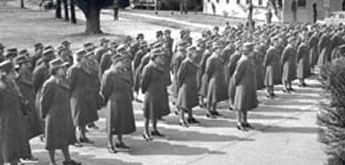
On March 3, 1943, the 67th WAAC Detachment reported to Fort Washington and became part of the Adjutant General’s School’s Service Company. They were assigned administrative, communications and transportation functions to replace men who were needed overseas. Most of Fort Washington’s women received their basic training at Daytona Beach, Florida, but a few had been trained at other centers. Captain Dorothy A. Tomhave was the first commander of Fort Washington’s WAAC Detachment. Shortly after arriving she was transferred to Fort Belvoir, and Captain Barbara Adair, one of the first 200 women recruited at Des Moines, became commanding officer. The detachment was turned over to Captain Lucille Rath when Captain Adair left a few months later. Lieutenant Marion P. Dunning was the Executive Officer, and the First Sergeant was Jean Harter during the entire time that the detachment was at the post. 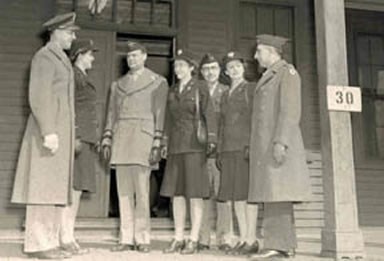
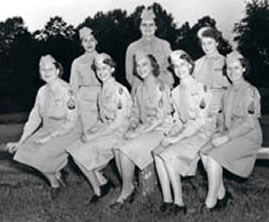
Donated to the park by a former WAC who was stationed at Fort Washington during World War II 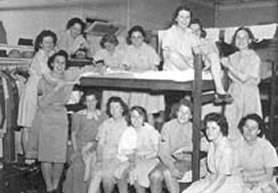
Fort Washington like other military posts completely lacked proper facilities to house women. One of the old Coast Artillery barracks was turned into women’s quarters and the ladies quickly dubbed it the WAC Shack. Wood bunk beds were still in use and although footlockers were provided, there were only shelves and clothes racks to hang uniforms. Unlike the men’s barracks, the women’s quarters were furnished with curtains, and separate shower stalls provided a little privacy.
WOMEN’S ARMY CORPS On August 31, 1943 the Women’s Army Auxiliary Corps of 60,000 was disbanded and the women dismissed from the service. The next day the newly formed Women’s Army Corps enlisted those that chose to remain in service, and offered full military rank and benefits for service connected injuries. The new corps also provided protection for the women if captured by the enemy forces. As members of the auxiliary, the women would have been treated as civilians, but now they were soldiers and eligible for the rights afforded prisoners of war. Seventy-five percent of the WAAC enlisted in the WAC, but 15,000 chose to return to civilian life. Staff Sergeant Virginia Evans’ most memorable event was the day that all the DC area women companies assembled at Fort Myers and were sworn into the WAC in a mass ceremony. On March 3, 1944, one year after the women arrived at the post, the 365th Army Service Band assembled in front of the WAC Barracks shortly after reveille and played Happy Birthday. This was a holiday for the women and the mess hall served a special dinner. Staff Sergeant Shirley Hassler wrote in her diary, “Anniversary dinner and it was swell. Made me proud to be a Fort Washington WAC.” The Adjutant General’s school moved to Fort Sam Houston, Texas on August 17, 1944. After the war the school moved to Fort Lee, Virginia then to Fort Benjamin Harrison, Indiana. 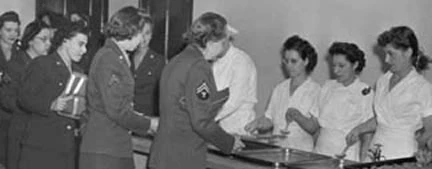
Photo donated by former WAC that was stationed at Fort Washington during World War II. |
Last updated: December 23, 2017
